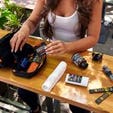He’s 6’3” tall and weighs 250 pounds. He can deadlift over 700 and drop into a full split right afterward. The man is so massive and flexible that he’s known by the nickname The Mobile Mammoth, and so movie-star handsome that he’s been compared to Chris Hemsworth and Brad Pitt.
So what the hell does the average guy or gal have in common with Brian Butz? Well, as it turns out, much more than you think.
The most impressive thing about the former Onnit Gym coach from Latrobe, PA, isn’t his physique or feats of strength, but rather his evolution from a husky farm boy who grew up playing magic tricks rather than sports and eating bowls of Frosted Flakes® snowed under in added sugar. Contrary to what his growing Instagram account may lead you to believe, Butz isn’t the poster boy for good genetics and divine favor. Instead, he’s living proof that we all have to start somewhere, and that anyone can leave that place behind if they choose to.
Butz, 29, spoke to us about his life and fitness journey, how he’s trying to single-handedly elevate the coaching profession, and his new workout app, the Mobile Mammoth Level 1.
Onnit: First, we need you to clarify something. We’ve never seen you and Thor in the same place before, so can you conclusively prove that you’re NOT, in fact, a Marvel superhero?
Brian Butz: [Laughs] That has become my nickname among some people. I’ve actually never seen any of those movies, but I get “You look like Chris Hemsworth” from people my age, and “You look like Brad Pitt” from older generations a lot.
Were you always a physical specimen?
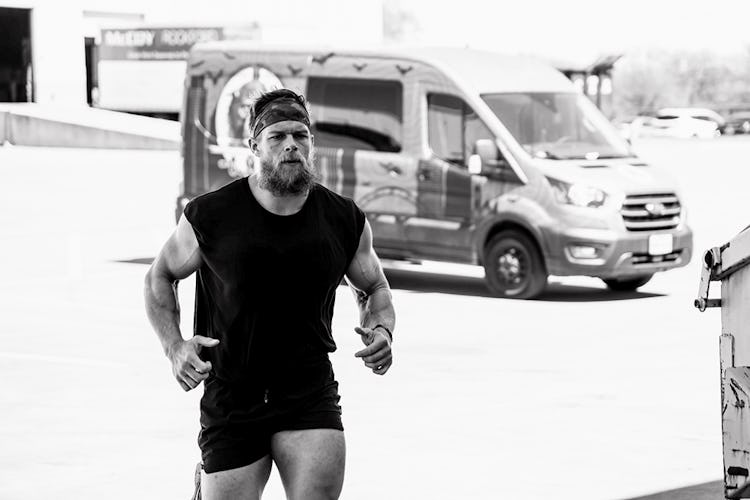
Not at all. My parents had zero concept of nutrition. I drank a lot of soda growing up, and my after-school snack was a giant bowl of Frosted Flakes® with two strawberry Pop-Tarts® broken up on top of them and four tablespoons of sugar on top of that. I didn’t have time to play sports because I grew up on a farm, and I was either working on that or working for my dad’s construction company, laying stone and pouring concrete. I started helping him when I was six and worked as a laborer every summer. When I did have time, I was into magic [laughs].
So how did you get into fitness?
I was 14, and my mom asked me one day if I needed a bra because I had such big boobies. She wasn’t kidding.
That’s when I said, “Fuck this.” I had seen commercials for the P90X® transformation program, and I spent $140 of my own money to get it and started working out. I couldn’t even do a pushup at first. Nowadays, I can deadlift 710 pounds and do full splits, so people like to say, “It’s easy for you to talk about fitness, because you’ve always been like this.” That’s when I tell them, “Eh, not really.” [Laughs]
So I did P90X® in my room every day. That program ended up being a big influence on my Mobile Mammoth Level 1 program that I offer now. You can do it in your garage. Since the pandemic began, many people have gotten a squat rack or other equipment that fits in a home gym, so, if you’re like I was back in the day, intimidated or uncomfortable going to a gym, you can train in your own room like I did with P90X®. One of a coach’s jobs is to eliminate barriers to exercise for clients, so creating a program that allows you to train in a place where you’re not self-conscious and you’re free from distractions was important to me, because that’s how I started.
After I lost some weight with P90X®, I wanted to go out for wrestling, because I knew all the wrestlers in my school were in great shape. I had a gym teacher who was also the wrestling coach. He was a really good guy—didn’t swear, but he was built like a tree, and his training was really diverse. He had us do synchronized swimming as part of our preparation. It turned out that I was pretty terrible at wrestling—I got my ass beat all the time. I’m not a tough guy. But Frank, the coach, supported me anyway. He was the first person who told me, “You can do this.” He told me I could be the first person in my family to go to college. That was a novel thing for me, because, at that time, I had no confidence. I never got much better at wrestling, but I did start believing in myself and pursuing other goals.
At the end of high school, I applied to Indiana University of Pennsylvania and got into their exercise science program. When I told my dad, he said, “That’s awesome. Now how are you going to pay for it?” I had always wanted to go into the Army anyway, so I signed up for an ROTC scholarship. They paid for three years of school, and I went into the Army afterward.
In 2016, I got stationed in Colorado Springs as a platoon leader. I didn’t become a war hero or a bad ass, but, as a First Lieutenant, I had $59 million of equipment under my supervision, and 80 personnel below me. I had to grow up really quickly. The attitude in the Army was, “You’re in charge, so don’t fuck this up.” I had to train people for combat, so I became good at planning, time management, and communication—because that’s how you get people to do things you need them to do when they’re wet, tired, hungry, or pissed off. That really paid off later when I became a trainer.
When did you know you wanted to do fitness for a living?
I married an Army nurse and, when I got out of the military, I moved to San Antonio to be with her. It didn’t work out—we were young and stupid, and some would say I still am [laughs]—but I stayed in Texas. It was really weird because I had an exercise science degree and an Army resume, but I couldn’t find a job anywhere.
I tried to do construction, but I couldn’t get work and ended up sitting on the couch watching The Sopranos. One day, I was working out in Gold’s Gym. I had been training back and was all pumped up, and, out of frustration, I walked into the manager’s office and said, “Hey, man, can I get a job here?” Maybe it was because of the way I looked, but he just said “Sure” right away.
I had some experience as a trainer because I had trained guys in the military—I was responsible for the physical fitness of the platoon. But I went out and got a training certification, and started training people at Gold’s. I really didn’t know what I was doing. The management told me to just go and get clients, so I applied the work ethic I grew up with. I was in the gym 12–14 hours a day, going from treadmill to treadmill talking people up, trying to win clients. I worked up to doing 70 sessions a week, seven days a week, and I became one of the best salesmen at the gym.
Part of my success was due to outworking the competition, but it was also my personality. I was very empathetic to people. My old coach, Frank, used to say that people don’t care how much you know till they know how much you care, and that stuck with me.
How did you find Onnit?

I had heard [Onnit co-founder] Aubrey Marcus on the Joe Rogan Experience podcast when I was in high school. He was talking about an ayahuasca experience that he had had and was actually crying. That made a huge impression on me.
Remember that I grew up around farmers, construction workers, and wrestlers. I was raised to think that if you were having an issue, the only solution was to raise yourself up by your bootstraps. There wasn’t a lot of space for a man to have feelings. But Aubrey was a guy who was jacked, and hunted fish with a speargun—and was also sensitive enough to cry in public. He showed me that a bad ass can also be in touch with his feelings. So I had known about Onnit for a while, and I had actually been taking Shroom Tech® SPORT before workouts for years and loved it.
Trainers know that if they get more certifications, they can charge more money, so I said to a bunch of the Gold’s trainers that we should go up to Onnit in Austin and take a cert course. In 2019, we went and did the kettlebell cert, and I left it telling myself that I had to work at Onnit someday. It became the mecca for me.
What about Onnit impressed you so much?
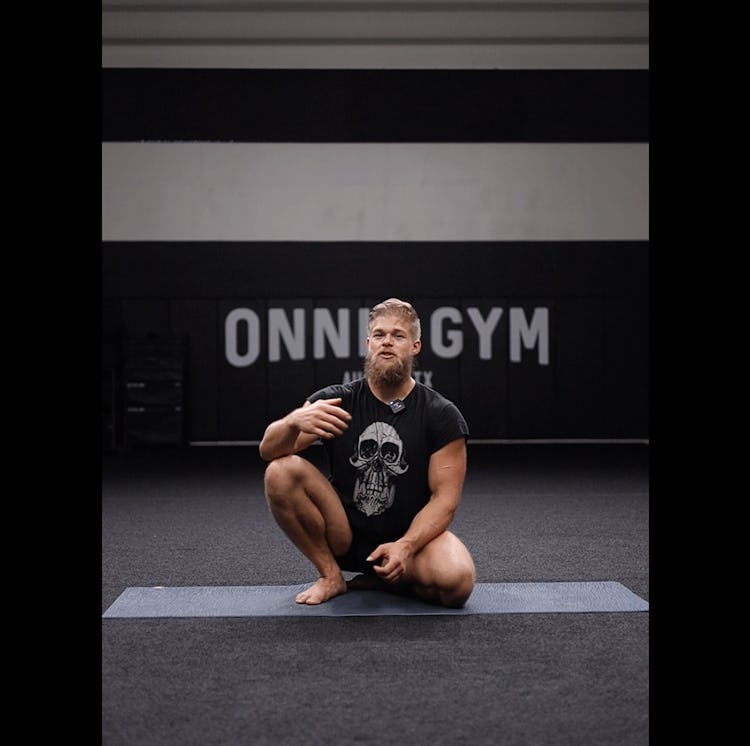
The kettlebell course was amazing, but there was something about Coach John Wolf [Onnit’s Chief Fitness Officer] that inspired me. He’s a very powerful guy who speaks and teaches well. Like Aubrey, he had a quiet confidence about him and showed that you can be strong and smart and friendly—a balanced person. He owned the room when he taught.
You know, I truly believe that fitness is a vehicle for teaching lessons in life. When I was younger, bodybuilding was very important to me. It was how I dealt with friends who were dying in the military. I worked off a lot of that stress and anger by lifting heavy weights. Then, one day, not long after I went to Onnit the first time, I did a workout where I front squatted 315 for 25 reps. It was awful. I sat down on a bench afterward and thought, “I’m not angry anymore. I want to heal.” Shortly after that, I took Onnit’s Durability certification. Shane Heins [co-creator of Onnit’s fitness education] actually said, “When I saw you come in, I saw this very big guy who looked like a lumberjack, but I could tell that you were just ready to change. I’m excited to see where you take Durability.”
That cert changed my life, and it’s now the basis of everything I do. First of all, Durability made me realize how tight I was. When I tried to do a shinbox sit, my front knee was five inches above the floor. So I stopped lifting entirely for six months and did the Durability moves every day—the mountain climber series, shinboxes, etc. I just did Durability and ran, and that’s it.
Then, in the fall of 2020, [Former Director of Fitness Programming] Juan Leija posted that Onnit Gym was looking for coaches. I messaged him saying I wanted the job, and he invited me to come do a workout with the other coaches. That was part of my job interview. He put us through the ringer, running with an 80-pound sandbag on our shoulders, among other things, but I was in great shape from all the cardio and mobility training. Juan offered me the job, and I moved to Austin.
I worked at Onnit a year, and it was a great experience. I learned a ton. But I recognized that it was getting time for me to step out on my own. There were people waiting a half-year to train with me at the gym, and I felt like I had to find a way to get my training to the masses.
John Wolf had told me that Onnit is a place where coaches come, learn and develop, and then move on to something else. It’s a springboard, not necessarily a destination. So, while it was terrifying to move on, I decided to step away from Onnit so I could develop the Mobile Mammoth plan.
Where did the idea for Mobile Mammoth training come from?
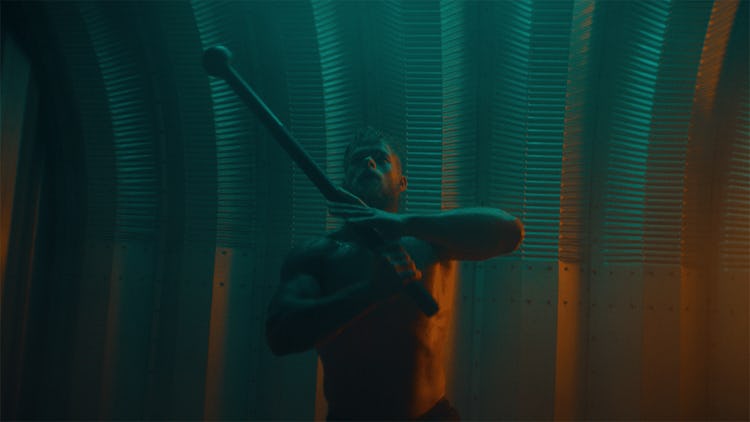
I had three questions I couldn’t get out of my mind. “What is fitness and why do we need it? What is being offered now in the market and what does it not address? And why is everybody getting hurt?” I thought that if I could answer those, I’d have a training system that would serve more people.
I wanted people to link fitness to life outside the gym. You should know what aspect of your life you want to improve with fitness, and how to train to get there. No one really wants to work out just to get better at working out. Most trainers I see don’t help their clients identify and set smart, specific goals, and I wanted to offer a program that did, no matter who you are. And as for the third question, why is everybody hurt, we need a better model to teach people how to take care of themselves. I’ve trained over 1,000 people now, and I’ve seen that, more than any other factor, what stops them from making progress always comes down to injury. We’re always hearing about female soccer players blowing out their ACLs, and 70% of people who go to physical therapy drop out after the third session—so it falls on trainers to not let them get injured in the first place.
So, in my system, posture is really important. We work on basic movement skills. I try to educate on simple but important things like how to breathe, how to brace the core. You know, for a long time, I was afraid that clients wouldn’t stay with me if I trained them like that. If I made them do bodyweight squats before barbell squats, focusing on fundamental positions. But I found that when you take the time to explain what you’re doing and why, and you show that it’s because you care about the client, they appreciate it and run with it. And believe me, I can make an exercise hard without adding weight to it. There are all kinds of ways to add intensity to your training, like adding a tempo to your reps, decreasing rest periods, upping the volume, working off one foot rather than two, and so on.
I have a weird amount of empathy and awareness. I can feel how people are, and I believe that how you show up for people and the attention that you give them is reciprocal. For the hour I’m in the gym with a client, we’re alone. I want them to leave thinking, “Wow, he really paid attention to me.” That can have a huge impact on people, and their fitness. I look at it this way—most people see their doctor maybe once a year, but if you have a trainer, you see them three times a week. We have a big responsibility, and an opportunity to really change lives.
Your mobility now is amazing, especially for a guy your size, but you mentioned that you used to be very inflexible. What do you recommend for people who want to start limbering up?
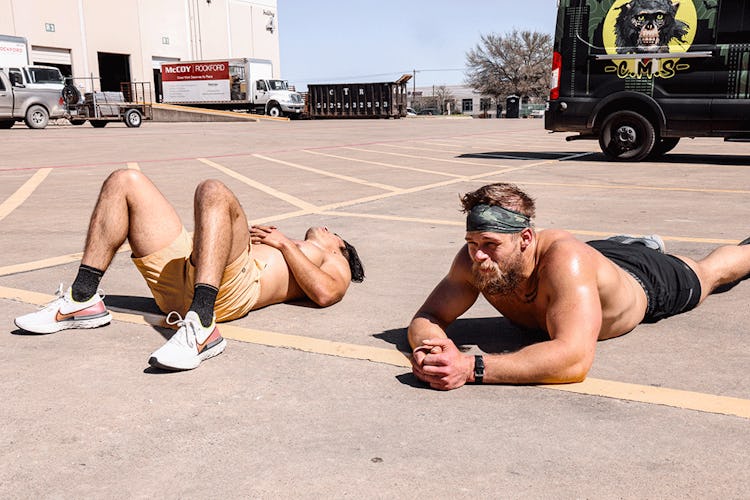
Spend time in the positions you’re trying to improve and work on owning the end ranges of motion. But also, work on the basics of a healthy lifestyle. Honestly, drinking more water and sleeping eight hours at night had the biggest impact on my mobility. It took me out of that fight-or-flight state, and rehydrated the tissue. In an ideal world, we wouldn’t have to do mobility, as basic healthy lifestyle guidelines would cover most of it.
In the Mobile Mammoth app, I put people in positions that challenge them while still letting them do exercises that are familiar and that they enjoy. For instance, there’s biceps curls in the program, but sometimes you’ll do them in different stances. You’re still training biceps, but when you do them in a staggered stance, there’s a balance component, you work hip extension, and you have to be mindful of keeping a neutral pelvis, so mobility and posture are built into the training.
Tell us more about your new app, Mobile Mammoth Level 1
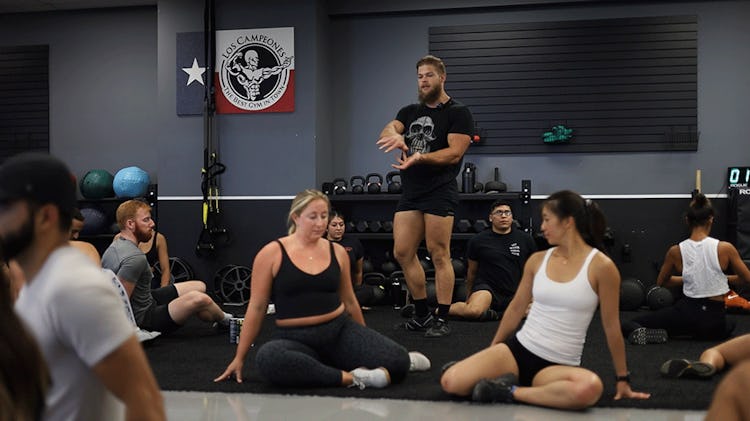
It’s available July 4 on Google Play for Android and iOS for iPhone. You get access to a program for 12 months—three days a week of resistance training and two days of cardio and mobility. You also get what I call Mobility Mammoth Minutes, which are 15-minute routines for when you don’t have time for a full workout. The workouts use equipment that most people have at home—a squat rack, landmine, and dumbbells or kettlebells.
I designed the app to teach people the fundamentals they need to do a hard reset on your fitness, and it will help you answer the question of where you can take your fitness afterward. It’s heavy on education, so it’s not just another program you do and are done with in 30 days. It will feel more like a course you take to learn about training. You can repeat the program again and again, progressing and regressing the exercises as needed.
Download The Mobile Mammoth Level 1 app at train.themobilemammoth.com, and follow Brian on Instagram, @themobilemammoth.
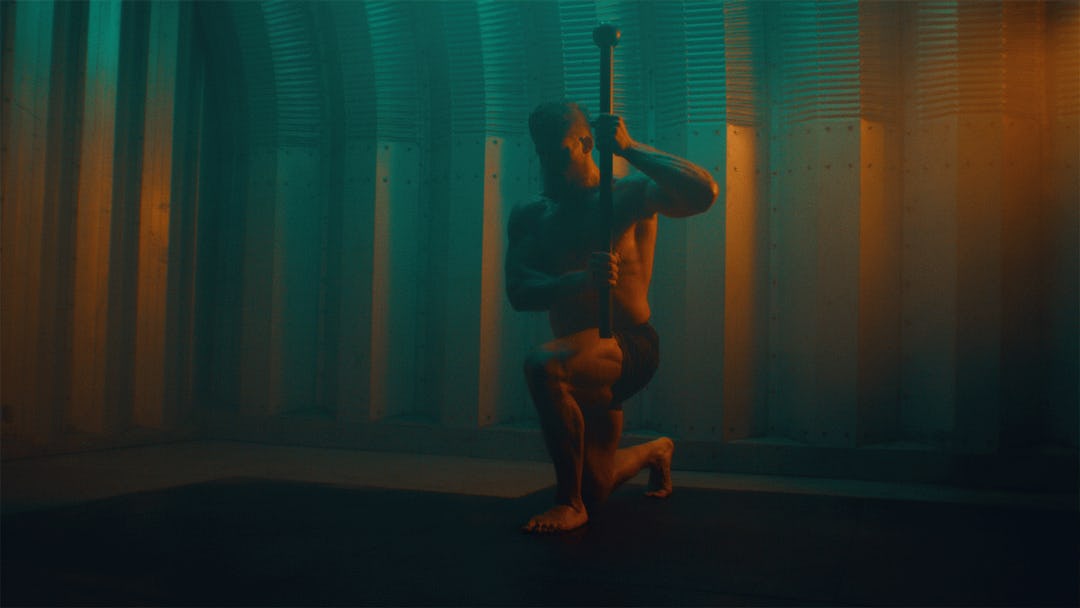
)
